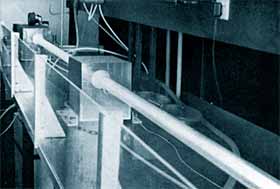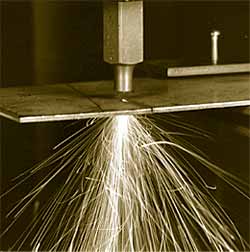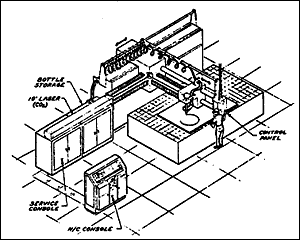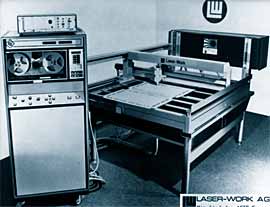History of Laser Cutting

An early commercial version of the SERL slow flow laser, manufactured by Ferranti
The first laser designed for the purpose of production was introduced by Western Electric in 1965. A leader in the manufacturing and electrical engineering spaces, this company has been a trailblazer in the industry for years, contributing to advanced forms of production. Western Electric began using lasers as a way of drilling holes into diamond dies in 1965, and the technology took off from there.

The first oxygen assist gas laser cutting performed in May 1967
By May of 1967 (just two years later), a German scientist named Peter Houldcroft had begun developing his own laser-cutting nozzle. This nozzle used a CO2 laser beam and oxygen assist-gas to experiment with industrial cutting. Thanks to these experiments, Houldcroft became the first person to use laser cutting to cut through a 1mm steel sheet. Western Electric quickly jumped on these advancements, making improvements to Houldcroft’s technology — soon enough, lasers were being sold to companies for industrial applications.

1969 concept for a laser cutting machine tool
In 1969, the Boeing company released a paper discussing the possibilities of using laser cutting on harder materials — such as ceramic and titanium. The paper suggested that, with significant development, laser cutting could become an effective tool for industrial cutting. This groundbreaking paper prompted many companies to begin evaluating the possibilities of laser cutting.

First 2 axis moving optics CO 2 laser cutting machine (1975). Photo courtesy of Laser – Work AG
As techniques advanced during the 1990’s, new possibilities emerged in the technique of laser sintering, and the first SteroLithography Apparatus, which allowed companies to create quick prototypes for future technology. By the time the millennium arrived, there were numerous techniques and methods available, raising the standards in laser cutting.
Laser Cutting as We Know It Today
At the beginning of the century, many industries worried that laser systems didn’t have the precision required for complicated designs — those issues are now a thing of the past.
Today’s laser cutting technologies are often integrated with computer-based programming systems, allowing for complete control when cutting various materials. Due to these precise solutions, lasers can now create various shapes and components without distortion, making them ideal for a number of modern industries. Thanks to its non-contact technology, laser machining is a valuable tool in the processing and manufacturing industries. Through its evolution, laser technology has allowed the world of manufacturing to achieve a level of speed and accuracy that Einstein himself may not have imagined — and with engineers constantly working on advancements, who knows where we’ll end up next.
Ruijie Laser, 18 years experience in engraving production.
more than 55,000 sqm.
Sold well in more than 120 countries.Established branch office.
if you need, pls feel free to contact us. ![]()
Contact person: Miss Anne
WhatsApp/Wechat: +86 15169801650
E-mail: sale12@ruijielaser.cc
Skype: Anne Sun
www.ruijielaser.cc
Jinan Ruijie Mechanical Equipment Co., Ltd.
Post time: Dec-18-2018
